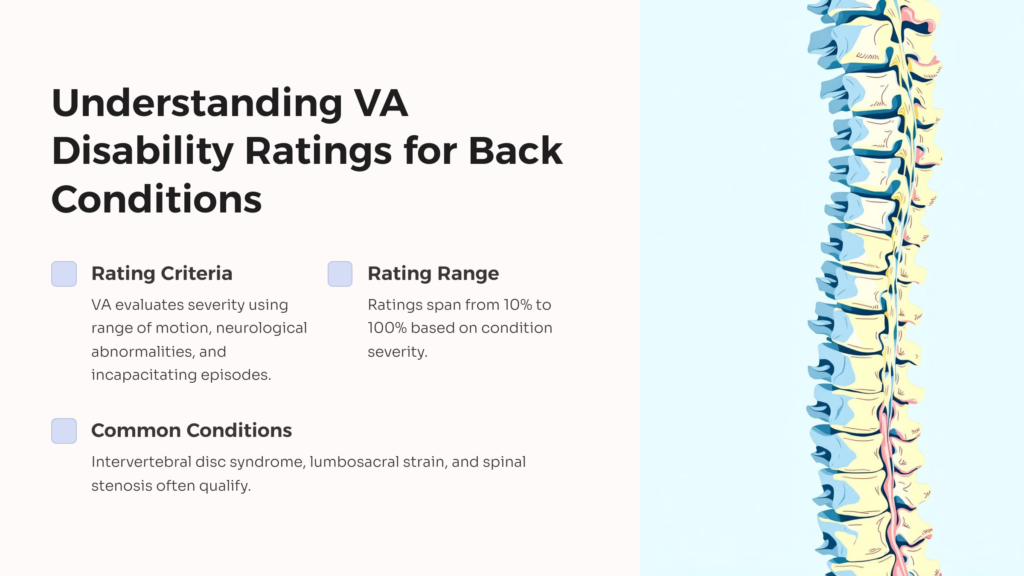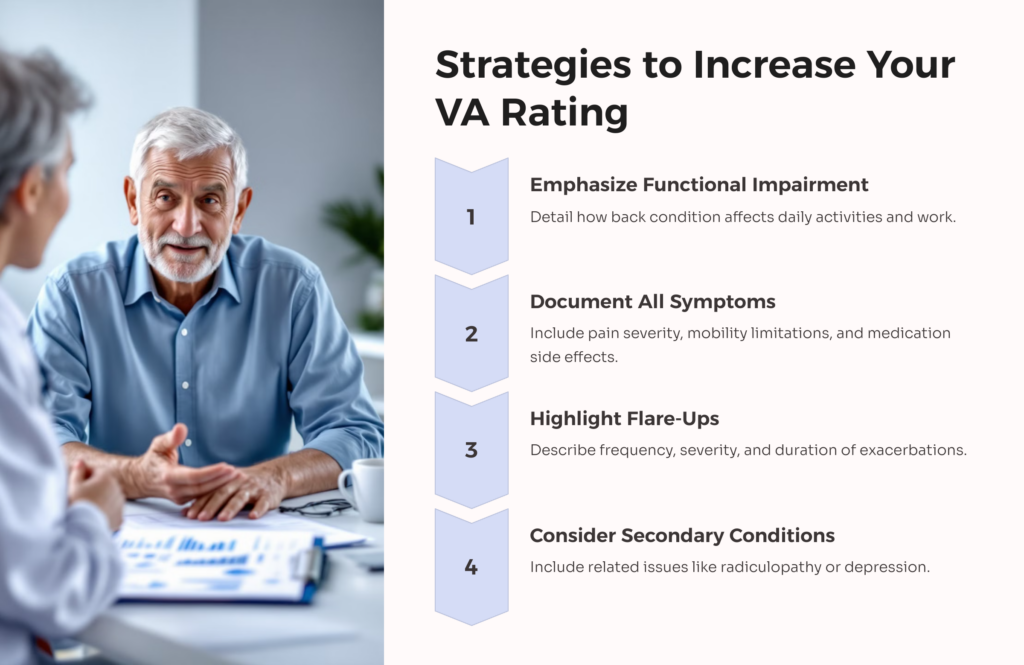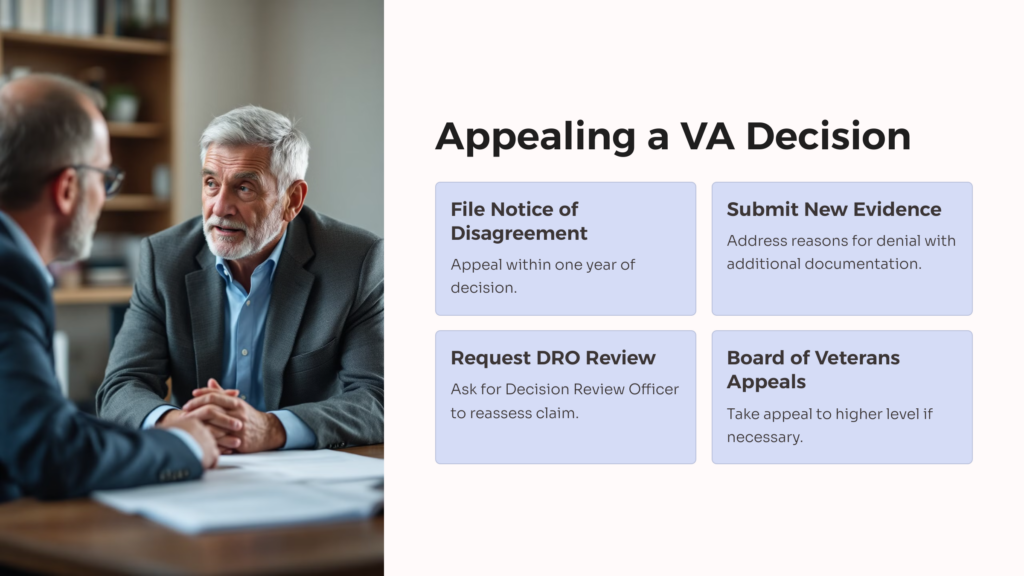The Department of Veterans Affairs (VA) uses rating criteria to evaluate the severity of a service connected disability and determine the percentage of disability compensation for spinal injuries or conditions. Some key factors include a range of motion measurements, neurological abnormalities, and incapacitating episodes due to intervertebral disc syndrome. The VA assigns back conditions ratings from 10 to 100%.

The average back pain VA disability rating varies greatly depending on the specific diagnosis and severity of symptoms. Minor conditions like a lumbar or cervical spine strain may receive 10 to 20%. More serious spinal injuries or disabilities like degenerative disc disease or spinal stenosis usually rate 20% or higher. Veterans with completely immobile spines and unfavorable neurological complications can qualify for 100% disability.
Intervertebral disc syndrome, lumbosacral strain, degenerative arthritis of the spine, and spinal stenosis are all conditions that will likely lead to a successful VA disability claim. Veterans with persistent back pain and functional loss due to these conditions often meet the criteria for service connected disability compensation.
Maximizing VA Benefits for Back Pain
How do I get 100% for back pain? To qualify for a 100% VA disability rating for a back condition, your VA claim must include medical evidence of an extremely severe spinal disability with significant neurological deficits and loss of functioning.
Some disabilities that can qualify for a 100% back pain disability rating are:
- Unfavorable ankylosis (complete immobility) of the entire spine
- Persistent neurological symptoms like bowel or bladder impairment
- Pronounced intervertebral disc syndrome with little intermittent relief
- Incapacitating episodes having a total duration of at least 6 weeks during a 12-month period
Proving a service connection is essential for obtaining any VA benefits for lower back pain. This requires demonstrating that your current back disability is linked to an injury, event, or illness during active military service. Useful evidence includes service medical records, buddy statements from witnesses, private doctor opinions, and records of ongoing symptoms.
How to Get a Higher VA Rating for Back Pain

The key to a higher VA rating is evidence that emphasizes how your back condition impairs functioning and quality of life.
Make sure to include:
- Severity of pain, stiffness, muscle spasms, numbness
- Reduced range of spinal motion measurements
- Mobility aid usage like cane, walker, wheelchair
- Effects on your ability to work, exercise, sleep, etc.
- Prescription pain medication usage and side effects
Thorough VA disability exams assessing all disabling effects of your back problem are also vital. Being open about limitations with daily activities can help convey seriousness.
Detailed Guide to VA Disability Benefits for Back Conditions
Claiming back conditions for Veterans Affairs disability compensation involves submitting medical evidence linking your current back diagnosis to an event or injury during qualifying active duty service.
Some common back problems eligible for VA benefits include:
- Herniated discs/degenerative disc disease
- Spinal stenosis
- Spondylolisthesis
- Radiculopathy
- Other neurological abnormalities
- Sprain or strain
- Vertebral fractures
- Spasms, tenderness, painful motion
- Arthritis/degeneration
Establishing a service connection for one of these back disabilities then allows the VA to assign an accurate rating and award monthly compensation if approved.
What Are Secondary Conditions of Back Pain?
Back injuries often lead to additional health complications called secondary conditions that can also qualify for VA benefits. Some examples include:
- Radiculopathy (nerve damage) in legs or arms
- Muscle atrophy from disuse
- Depression or anxiety from chronic pain
- Sleep disturbances
- Obesity from reduced activity
- High blood pressure from medications
Getting rated for these additional disabilities allows increasing your combined rating higher than the back problem alone.
Can I get a VA rating for multiple back conditions? Yes, veterans can absolutely be rated for several back disabilities simultaneously if the evidence supports it. For example, common combinations for a VA disability claim can include disc disease with radiculopathy or spinal stenosis with associated arthritis changes.
The VA distinguishes between disabilities affecting different spinal regions, allowing separate evaluations. Regions include the cervical (neck), thoracic (mid back), lumbar (low back), and sacral spine. So you could conceivably have concurrent ratings for lumbar strain and cervical spondylosis if military service caused both.
How to Increase Your VA Disability Rating for Back Pain
Other ways to increase your VA disability rating for back pain include citing effects on employment and providing evidence of flare-ups worsening your condition episodically.
Being unable to secure or maintain substantially gainful work due to service connected disabilities like lower back pain may make you eligible for individual unemployability benefits to increase compensation. TDIU can pay at the 100% rate regardless of your rating if your health issues prevent working.
Also emphasize in disability exams how back flare-ups periodically worsen your range of motion, pain levels, functionality, etc. The examiner must consider these exacerbations in assessing your highest level of impairment. Detail frequency, severity, and duration.
Benefits for Different Types of Back Pains
The VA uses a General Rating Formula for evaluating most service-connected back disabilities like disc disease, spinal stenosis, sciatica, spondylosis, sprains and strains, etc. Ratings range from 10 to 100% depending on symptoms like:
- Abnormal spinal contour
- Reduced forward flexion range of motion
- Muscle spasm, tenderness, pain on movement
- Nerve damage causing extremity weakness or sensory loss
- Ankylosis (complete joint immobility)
So the more evidence of debilitating symptoms in these criteria, the higher the rating.
Lower back pain accompanied by flare-ups warrants a higher rating accounting for additional loss of motion, pain, weakness, and fatigue causing even more loss of functioning during exacerbations.
Many veterans experience lumbar strain which involves pulled muscles and ligaments in the lower back. This often arises during military training requiring heavy lifting, marches with packs, overseas deployments, or riding in vehicles bouncing on rough terrain. The VA often awards 10 to 40% ratings for limited motion and pain.
Qualifying for VA Back Injury Benefits
A service connection for a back condition requires evidence linking it to an event, injury or illness during active military service. Helpful records include:
- Service treatment records showing back problems
- Buddy statements from witnesses
- Private medical records demonstrating ongoing symptoms after discharge
- Physician nexus opinions relating current diagnosis to military service
- Personal statements on onset circumstances
The VA rates back disabilities based on range of motion loss with forward flexion as the primary consideration. Reduced motion, muscle spasms, abnormal gait, neurological symptoms, and episodes are acute signs or symptoms warranting bed rest all impact ratings from 10 to 100%.
Seeking Legal Help
Attorneys understand VA disability benefits for back injuries. The complex VA system can seem overwhelming when trying to file claims yourself. Seeking help maximizes success. An experienced attorney assists by:
- Reviewing decisions for wrongly denied evidence
- Submitting appeals highlighting overlooked facts
- Gathering robust medical evidence from doctors
- Securing independent medical opinions if necessary
- Advocating for proper diagnostic testing if applicable
- Arguing for higher rating assignments matching the severity
A VA disability attorney can help guide and represent you through the multi-step claims and appeals process. Having a trusted advisor in your corner makes navigating the bureaucracy much less frustrating.
Optional Steps if Denied VA Disability Rating

What to do if your rating is denied or is too low? You have options if the VA denies your back claim or assigns too low of a rating:
- File a Notice of Disagreement to appeal within one year of the decision
- Submit additional evidence addressing reasons for denial
- Get an exam for a new diagnosis if the condition progresses
- Request a Decision Review Officer review at your local office
- Take your appeal to the Board of Veterans Appeals
Attending your VA compensation and pension exam is critical. Cooperate fully during the exam, clearly describing all symptoms affecting function. Be honest about problems standing, walking, lifting, sitting, etc. This exam largely determines rating, so emphasize deficits.
More About VA Disability Compensation
Can I get VA benefits if my back problems aren’t related to a specific injury? Yes, veterans can still qualify even without an acute injury causing back disability. Gradual wear and tear to the spine during active duty also warrants compensation. Rigors of military duties often lead to early degenerative changes.
Factors that affect your VA disability compensation for back pain include age, occupation duties, flare-ups worsening impairment, effects of pain medication side effects, and impact on concentration and memory. Discuss these with examiners.
Higher ratings match reductions in functioning and earnings. VA aims to compensate veterans appropriately, helping offset disability’s financial hardships and lost wages.
Understanding Lumbar Strain
Lumbar strain is among the most common back conditions in veterans. How does VA rate lumbar strain? Under the rating schedule, lumbar strain receives a 10% rating for localized tenderness not resulting in abnormal gait or spinal contour. Higher 20 to 40% ratings apply for muscle spasm attacks or guarding severe enough to cause abnormal gait or spinal contour, reflecting more serious disability.
Can Lumbar Strain Qualify as a Secondary Disability?
Yes, lumbar strain frequently arises secondarily from altered body mechanics compensating for another primary back disability. Examples include degenerative disc disease forcing overuse of muscles or vertebral fracture resulting in asymmetric stresses. Carefully document any underlying spinal disabilities.
VA disability compensation for lumbar strain covers painful limited motion, muscle spasms, stiffness, and reduced endurance for bending, lifting, and mobility. Ratings depend on the range of motion measurements for forward flexion, with higher awards for more restricted movement.
 AllVeteran.com Advisors
AllVeteran.com Advisors
With expertise spanning local, state, and federal benefit programs, our team is dedicated to guiding individuals towards the perfect program tailored to their unique circumstances.


















